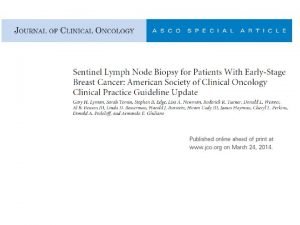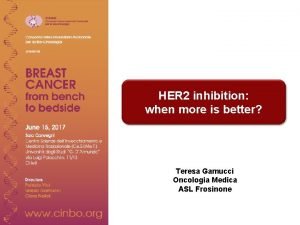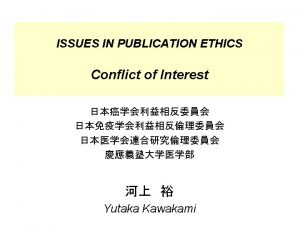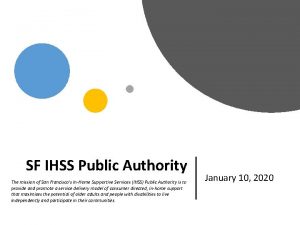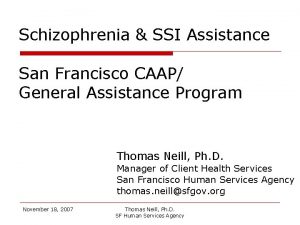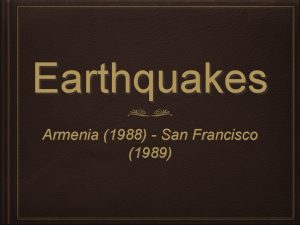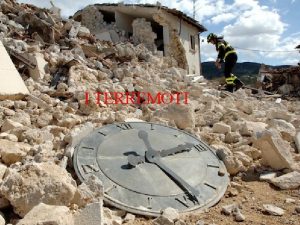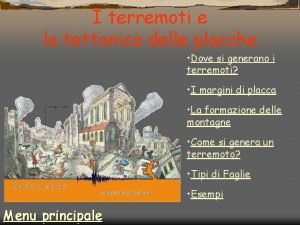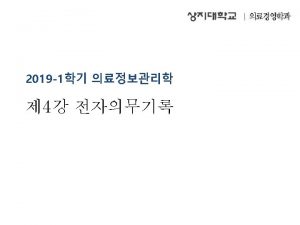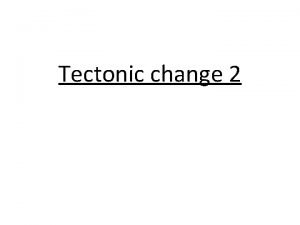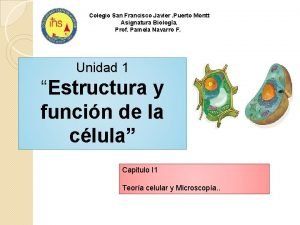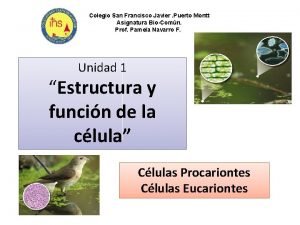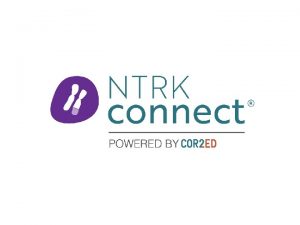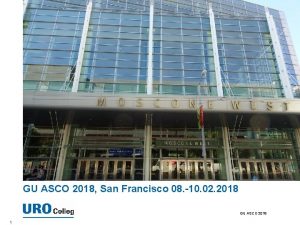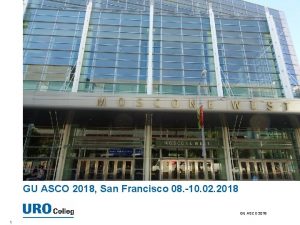MEETING SUMMARY ASCO GU 2020 San Francisco USA





































- Slides: 37


MEETING SUMMARY ASCO GU 2020, San Francisco, USA Dr. Neal Shore Medical Director Carolina Urologic Research Center, South Carolina, USA PROSTATE CANCER UPDATE 2

DISCLAIMER Please note: The views expressed within this presentation are the personal opinions of the author. They do not necessarily represent the views of the author’s academic institution or the rest of the GU CONNECT group. This content is supported by an Independent Educational Grant from Bayer. 3

INTERESTING ORAL PROSTATE CANCER PRESENTATIONS AT ASCO GU 2020 4

ANALYSIS OF SMALL NON-CODING RNAs IN URINARY EXOSOMES TO CLASSIFY PROSTATE CANCER INTO LOW-GRADE (GG 1) AND HIGHER GRADE (GG 2 -5) Klotz L, et al. ASCO GU 2020. Abstract #277 Oral Presentation 5

INTRODUCTION • A new predictive test for prostate cancer was developed based on small non-coding RNAs (snc. RNA) isolated from urinary exosomes • The test is non-invasive for diagnosis and prognosis of prostate cancer – Based on urine samples – Does not require DRE or first pass urine • Three tests were developed, each using 200 -280 selected snc. RNA to classify disease status: – PCa Assay – distinguishes patients with prostate cancer (GG 1 -GG 5) from those with no evidence of prostate cancer – CS Assay – distinguishes low-risk and low-grade prostate cancer (GG 1) from highergrade and higher-risk (GG 2 -GG 5) disease – HG Assay – distinguishes low and favourable-intermediate grade (GG 1 -GG 2) from high -grade (GG 3 -GG 5) disease • All 3 tests can be performed on a single 20 m. L urine sample CS, clinically significant; DRE, Digital rectal examination; HG, high grade; Pca, prostate cancer; snc. RNA, small non-coding RNA Klotz L, et al. ASCO GU 2020 Abstract #277 Oral Presentation 6

STUDY DESIGN • Discovery cohort – interrogated 6599 snc. RNAs from 235 patients • Validation cohort – 1436 patients – 836 patients in training dataset (fully cross-validated) – 600 separate patients in testing dataset N=300 No Cancer on Bx N=300 Cancer GG 1 2 GG 3 -5 N=146 N=54 N=100 • PCa, CS and HG tests performed on separate customised Open. Arrays containing informative snc. RNAs specific for each test Bx, biopsy; CS, clinically significant; GG, grade group classification; HG, high grade; Pca, prostate cancer; snc. RNA, small non-coding RNA Klotz L, et al. ASCO GU 2020 Abstract #277 Oral Presentation 7

RESULTS • Pca Test: sensitivity 94%; specificity 92%; PPV 92%; NPV 94% • CS Test (GG 1 vs GG 2 -5): sensitivity was 93%; specificity 90%; PPV 91% and NPV 92% • HG Test (GG 1 -2 vs GG 3 -5): sensitivity was 94%; specificity 96%; PPV 91% and NPV 97% Pca test CS test HG test AUC, area under the curve; CS, clinically significant; HG, high grade; NPV, negative predictive value; Pca, prostate cancer; PPV, positive predictive value Klotz L, et al. ASCO GU 2020 Abstract #277 Oral Presentation 8

CONCLUSIONS • Sequential analysis of small non-coding RNAs from single urine samples without DRE has enabled development of 3 assays for the presence of prostate cancer: – PCa test: cancer versus no cancer – CS test: low risk cancer (GG 1) versus higher grade, higher risk cancer (GG 2 -GG 5) – HG test: low to intermediate cancer (GG 1 -GG 2) versus high grade cancer (GG 3 -GG 5) (HG test) • Initial evaluation of these assays in a validation cohort of 1436 men demonstrated a high level of accuracy and AUC • Further validation studies are ongoing including validation of radical prostatectomy pathology AUC, area under the curve; CS, clinically significant; DRE, digital rectal exam; HG, high grade; Pca, prostate cancer Klotz L, et al. ASCO GU 2020 Abstract #277 Oral Presentation 9

TRANSCRIPTOME PROFILING OF NRG/RTOG 9601: VALIDATION OF A PROGNOSTIC GENOMIC CLASSIFIER IN SALVAGE RADIOTHERAPY PROSTATE CANCER PATIENTS FROM A PROSPECTIVE RANDOMISED TRIAL Feng FY, et al. ASCO GU 2020. Abstract #276 Oral Presentation 10

INTRODUCTION • Decipher is a 22 -gene genomic classifier (GC) that estimates the risk of distant metastases in prostate cancer patient's post-radical prostatectomy (RP) • Decipher has been used in > 130 manuscripts: – – Single & multicenter retrospective studies Meta-analyses Prospective registries Prospective single-arm trials • It has not been validated in the context of a post-prostatectomy trial • The GC was calculated in a randomised, phase 3 clinical trial of salvage radiotherapy (s. RT) with and without 2 years of bicalutamide treatment – Test the hypothesis that the Decipher GC will be independently prognostic for the development of distant metastases and overall survival GC, genomic classifier; RP, radical prostatectomy; s. RT, salvage radiotherapy Feng FY, et al. ASCO GU 2020 Abstract #276, Oral Presentation 11

NRG/RTOG 9601 STUDY DESIGN Recurrent PCa (PSA 0. 2 -4. 0) AND p. T 3 or p. T 2 with (+) margin S T R A T I F Y Sample size: 760 patients Median follow up: 13 years Entry PSA (1. 5 ng/m. L) Post-surgery Nadir PSA Prior ADT Margin status R A N D O M I Z E Salvage RT Placebo (2 years) Bicalutamide (2 years) Primary endpoint: Overall survival (HR 0. 77, p=0. 04) • FFPE tissue from RP specimens from patients enrolled in the NRG/RTOG 9601 trial were examined • 352 samples passed quality control – 176 samples were from patients assigned to s. RT + Plb – 176 samples were from patients assigned to s. RT + bicalutamide ADT, androgen deprivation therapy; HR, hazard ratio; Pca, prostate cancer; Plb, placebo; PSA, prostate specific antigen; RT, radiotherapy; s. RT, salvage radiotherapy Shipley W, et al. NEJM 2017; 376: 417 -28; Feng FY, et al. ASCO GU 2020 Abstract #276, Oral Presentation 12

RESULTS 22 -GENE DECIPHER GENE CLASSIFIER RISK STRATIFIES ALL OUTCOMES Distant metastases Prostate cancer specific mortality DM, distant metastases; PCSM, prostate cancer –specific mortality Feng FY, et al. ASCO GU 2020 Abstract #276, Oral Presentation 13

RESULTS 22 -GENE DECIPHER GENE CLASSIFIER RISK STRATIFIES ALL OUTCOMES Overall survival OS, overall survival Feng FY, et al. ASCO GU 2020 Abstract #276, Oral Presentation 14

RESULTS DECIPHER GC REMAINS A SIGNIFICANT PREDICTOR OF OUTCOME IN A MULTIVARIABLE MODEL Variable Hazard ratio (95% CI) P-value Distant Metastases Hazard ratio (95% CI) P-value Hazard ratio (95% CI) PCSM P-value OS Decipher score 1. 17 (1. 05 -1. 32) 0. 006* 1. 39 (1. 20 -1. 63) <0. 001* 1. 17 (1. 06 -1. 29) 0. 002* Treatment vs. placebo 0. 62 (0. 39 -0. 97) 0. 037* 0. 53 (0. 30 -0. 92) 0. 024* 0. 82 (0. 57 -1. 19) 0. 293 Age 65+ vs. 65 - 1. 30 (0. 83 -2. 06) 0. 247 1. 52 (0. 88 -2. 66) 0. 136 1. 95 (1. 33 -2. 91) <0. 001* Black vs. non-black 0. 88 (0. 28 -2. 13) 0. 798 0. 86 (0. 17 -2. 73) 0. 827 1. 35 (0. 57 -2. 77) 0. 467 Gleason 8 -10 vs. ≤ 7 2. 11 (1. 24 -3. 47) 0. 007* 2. 53 (1. 38 -4. 49) 0. 003* 1. 87 (1. 20 -2. 85) 0. 007* T 3 vs. T 2 1. 42 (0. 82 -2. 58) 0. 220 2. 01 (0. 97 -4. 62) 0. 061 1. 24 (0. 79 -1. 97) 0. 350 Entry PSA 1. 16 (0. 88 -1. 49) 0. 264 1. 37 (1. 01 -1. 80) 0. 041* 1. 08 (0. 84 -1. 35) 0. 530 Positive surgical margins 0. 71 (0. 44 -1. 16) 0. 167 1. 26 (0. 68 -2. 44) 0. 465 0. 98 (0. 64 -1. 53) 0. 919 Non-nadir vs. nadir PSA (<0. 5 ng/ml) 1. 31 (0. 62 -2. 51) 0. 456 2. 10 (0. 92 -4. 26) 0. 074 1. 98 (1. 13 -3. 30) 0. 019* Hazard ratios of GC were per 0. 1 unit increased. *indicates statistical significance CI, confidence interval; GC, gene classifier; OS, overall survival; PCSM, prostate cancer-specific mortality; PSA, prostate specific antigen Feng FY, et al. ASCO GU 2020 Abstract #276, Oral Presentation 15

ABSOLUTE BENEFIT Entire cohort Early salvage RT (PSA <0. 7 ng/m. L) GC, gene classifier; OS, overall survival; PCSM, prostate cancer-specific mortality; PSA prostate specific antigen; RT, radiotherapy Feng FY, et al. ASCO GU 2020 Abstract #276, Oral Presentation The absolute benefit from hormone therapy is smaller in the low Decipher GC risk group 16

CONCLUSIONS • This prospective randomised trial cohort demonstrated association of the GC with DM and PCSM independent of standard clinicopathologic variables • GC may help personalise shared decision-making to weigh the absolute benefit from the addition of bicalutamide to s. RT • At this time, biomarkers are not referenced in any prostate cancer guidelines – Without guidance, it is unclear how these should be operationalised in the context of clinical variables • Ongoing randomised trials will support the use of biomarkers: – NRG GU 006 study – PREDICT-RT (NRG-GU 009) – ERADICATE DM, distant metastases; GC, genomic classifier; PCSM, prostate cancer –specific mortality; s. RT, salvage radiotherapy Feng FY, et al. ASCO GU 2020 Abstract #276, Oral Presentation ; Lin, D. Presentation at ASCO GU 2020 17

KEY PROSTATE CANCER POSTER PRESENTATIONS AT ASCO GU 2020 18

PROs FROM A PHASE 1/2 DOSEESCALATION STUDY OF FRACTIONATED DOSE 177 LU-PSMA 617 FOR PROGRESSIVE m. CRPC Panagiotis J, et al. ASCO GU 2020. Abstract #45 (Poster presentation) m. CRPC, metastatic castration resistant prostate cancer; PSMA, prostate specific membrane antigen 19

INTRODUCTION • Radionuclide therapy may be able to treat symptoms related to tumour and therefore may improve patient-reported outcomes (PROs) • This was the first dose-escalation study of PSMA-targeted radionuclide therapy with 177 Lu-PSMA-617 • Dose fractionation was used to deliver a dose-intense regimen intended to minimise radioresistance due to repopulation METHODOLOGY • Patients with progressive m. CRPC following potent ARPI, (e. g. abi/enza) and taxane (or unfit/refuse chemo) without limit of number of prior therapies, adequate organ function, ECOG performance status 0 -2, without preselection for PSMA expression were included • Treatment was a single cycle of fractionated dose 177 Lu-PSMA-617 on D 1 and D 15 (7. 4 to 22 GBq in phase 1; 22. 2 GBq in phase 2) • PRO tools included FACT-P and BPI-SF at baseline and follow up Abi, abiraterone; BPI-SF, Brief Pain Inventory – Short Form; ECOG, Eastern Cooperative Oncology Group; enza, enzalutamide; FACT-P, Functional Assessment of Cancer Therapy Prostate Module; GBq, gigabecquerel; Lu, Lutetium; m. CRPC, metastatic castration resistant prostate cancer; PRO, patient reported outcomes; PSMA, prostate specific membrane antigen Panagiotis J, et al. ASCO GU 2020 Abstract #45 (Poster presentation) 20

BASELINE DATA Baseline data Median age (range) Median PSA N=44 69 (55 -91) 182. 97 (0. 89 -5541) Sites of metastases: Bone Nodal Lung Liver Other visceral metastases 93% 45% 18% 9% 9% Prior therapies: At least 1 prior CT regimen ≥ 2 prior ARPI Ra-223 Sipuleucel-T 177 Lu-J 591 55% 52% 27% 30% 5% ARPI, androgen receptor pathway inhibitior; CT, chemotherapy; Lu, Lutetium; PSA, prostate specific antigen; Ra-223, Radium-223 Panagiotis J, et al. ASCO GU 2020 Abstract #45 (Poster presentation) 21

RESULTS Efficacy endpoints Result > 50% decline PSA 22. 2 GBq (600 m. Ci) 59. 1% 66. 7% Median overall survival Safety endpoints Treatment emergent AEs: Pain Xerostomia Fatigue Nausea Thrombocytopenia AST elevation Anaemia Neutropenia • 16 mo 95% CI: 11 -NR Grade 1 N (%) Grade 2 N (%) Grade 3 N (%) 19 (43. 2%) 25 (56. 8%) 6 (13. 6%) 21 (47. 7%) 9 (20. 5%) 8 (18. 2%) 4 (9. 1%) 2 (4. 5%) 17 (38. 6%) 2 (4. 5%) 12 (27. 3%) 1 (2. 3%) 5 (11. 4%) 1 (2. 3%) 6 (13. 6%) 3 (6. 8%) 0 0 1 (2. 3%) 0 3 (6. 8%) 0 Pain flare and xerostomia were the most common AEs, occurring in 81. 8% and 61. 4% of subjects respectively (both generally low grade and temporary) AE, adverse event; CI, confidence interval; GBq, gigabecquerel; NR, not reached; PSA, prostate specific antigen Panagiotis J, et al. ASCO GU 2020 Abstract #45 (Poster presentation) 22

PSA RESPONSE • 81. 8% of patients experienced any PSA decline, despite no selection for PSMA+ • 59. 1% of patients had a >50% PSA decline • At phase 2 dose (600 m. Ci), 66. 7% patients had > 50% PSA decline 50 Best PSA change from baseline 0 -50 -100 m. Ci, millicuries; PSA, prostate specific antigen; PSMA, prostate specific membrane antigen Panagiotis J, et al. ASCO GU 2020 Abstract #45 (Poster presentation) Dose (m. Ci) 200 300 400 500 600 23

PATIENT-REPORTED OUTCOMES • FACT-P scores improved in all categories by D 22 (1 week later) • Overall FACT-P scores improved by a mean of 8. 9 points (p=0. 07) at D 22 and remained improved at 12 weeks • All BPI scores improved – BPI overall severity score improved by a mean of 3. 0 at D 22 (p=0. 008) and remained better than baseline at 12 weeks • There was no clear association with any AE and PRO changes – Those with a PSA decline tended to have improved pain scores (p=0. 1) AE, adverse event; BPI, Brief Pain Inventory; FACT-P, Functional Assessment of Cancer Therapy Prostate Module; PRO, patient reported outcomes; PSA, prostate specific antigen Panagiotis J, et al. ASCO GU 2020 Abstract #45 (Poster presentation) 24

CONCLUSION • A single cycle of up to 22. 2 GBq of 177 Lu-PSMA-617 is safe with fractionated (D 1 & D 15) dosing • Encouraging early efficacy signals were observed in a population unselected for PSMA expression and improved Qo. L and pain scores by validated PRO instruments GBq, gigabecquerel; PRO, patient reported outcomes; PSMA, prostate specific membrane antigen; Qo. L, quality of life Panagiotis J, et al. ASCO GU 2020 Abstract #45 (Poster presentation) 25

CLINICAL OUTCOMES AND PATIENT PROFILES IN REASSURE: AN OBSERVATIONAL STUDY OF RADIUM-223 IN METASTATIC CASTRATION-RESISTANT PROSTATE CANCER (m. CRPC) Higano CS, et al. ASCO GU 2020. Abstract #32 (Poster presentation) m. CRPC, metastatic castration resistant prostate cancer 26

INTRODUCTION • Radium-223 is a targeted alpha therapy that demonstrated a survival advantage and favourable safety profile in the ALSYMPCA trial 1 • Treatment with Ra-223 leads to radiation exposure, therefore long-term follow up of patients is important to determine the long-term risk of developing a second primary malignancy (SPM)2 • The REASSURE trial evaluated the short and long-term safety of Ra-223 in patients with m. CRPC in routine clinical practice over a 7 -year follow-up period 2 – Results from the second planned interim analysis are presented m. CRPC, metastatic castration resistant prostate cancer; Ra-223, Radium-223; SPM, second primary malignancy 1. Parker C, et al. NEJM 2013; 369: 213 -23; 2. Higano CS, et al. ASCO GU 2020 Abstract #32 (Poster presentation) 27

REASSURE STUDY DESIGN • Global, prospective, single-arm, observational study • 1465 patients enrolled Long-term follow-up Decision to treat patient with radium-223 First injection Death, withdrawal, lost to follow-up Last injection Initial baseline visit 30 days 6 months after last injection Study end: maximum 7 years after last injection Treatment phase 6 months follow-up Second prespecified interim analysis: data cut-off March 20, 2019; Median FU 11. 5 months Patient population: • m. CRPC with bone metastases • Scheduled to receive Ra-223 prior to study enrolment • No previous treatment with Ra-223 or other radiopharmaceuticals Primary endpoints: • Incidence of second primary malignancies (SPM) • Bone marrow suppression • Short and long-term safety in patients with ≥ 1 dose Ra-223 Key secondary endpoint: • Overall Survival • Incidence of bone fractures • No. of bone-associated events • PROs (BPI-SF scores) BPI-SF, brief pain inventory – short form; FU, follow-up; PRO, patient reported outcomes; Ra-223, Radium-223; SPM, second primary malignancies Higano CS, et al. ASCO GU 2020 Abstract #32 (Poster presentation) 28

BASELINE DATA Safety population (N=1465) Baseline data Laboratory values Median PSA (n=1053) 59 ng/m. L Median ALP (n=1048) 135 U/L Median LDH (n=555) 269 U/L Extent of disease, n (%) Patients with bone metastases only 1193 (81) Patients with metastases at other sites* 272 (19) Patients with <6 metastatic sites 259 (19) Patients with 6 -20 metastatic sites 636 (47) Patients with >20 metastatic sites 270 (20) Superscan 81 (6) Prior therapy, n (%): Abiraterone/prednisone Docetaxel Enzalutamide Cabazitaxel Sipuleucel-T 665 (45) 555 (38) 548 (37) 132 (9) 123 (8) Median number of Ra-223 doses 6 Patients with ≥ 5 dose of Ra-223 67% *predominantly in lymph nodes ALP, alkaline phosphatase; LDH, lactate dehydrogenase; PSA, prostate specific antigen; Ra-223, Radium-223 Higano CS, et al. ASCO GU 2020 Abstract #32 (Poster presentation) 29

RESULTS Primary Endpoints N=1465 N (%) Secondary Primary Malignancy 14 (1) Any AE 701 (48) Treatment-emergent drug-related AE 510 (35) Grade ≥ 3 155 (11) Resulting in Ra-223 discontinuation 82 (6) Bone marrow suppression 178 (12) Most common TEAE any grade: Diarrhoea Nausea Anaemia 157 (11) 127 (9) 122 (8) Treatment emergent SAE 311 (21) Drug-related SAE 80 (5) Death due to drug-related SAE 11 (1) Secondary Endpoints N=1465 N (%) Median Overall Survival 15. 6 months (95% CI: 14. 6 -16. 5) Fractures AE, adverse event; CI, confidence interval; Ra-223, Radium-223; SAE, serious adverse event; TEAE, treatment emergent adverse event Higano CS, et al. ASCO GU 2020 Abstract #32 (Poster presentation) 70 (5) 30

CONCLUSIONS • Following treatment with Ra-223 in the REASSURE study there was a low incidence of: – Second primary malignancy – Bone fractures – Bone marrow suppression • No new AEs were identified • The REASSURE study confirms that in routine clinical practice the Ra-223 AE rates were low, and most patients completed the full course (6 injections) of Ra-223 treatment AE, adverse event; Ra-223, Radium-223 Higano, CS et al. ASCO GU 2020 Abstract #32 (Poster presentation) 31

ADVERSE EVENT PROFILES OF APALUTAMIDE, ENZALUTAMIDE AND DAROLUTAMIDE IN SPARTAN, PROSPER AND ARAMIS: HOW CONFIDENT ARE WE ABOUT WHICH DRUG IS SAFEST? Drago JZ, et al. ASCO GU 2020. Abstract #318 (Poster presentation) 32

INTRODUCTION • Apalutamide, enzalutamide and darolutamide were approved for nonmetastatic castration-resistant prostate cancer (nm. CRPC) based on 3 randomised trials: – SPARTAN 1 – PROSPER 2 – ARAMIS 3 • Similar efficacy was observed in these trials whereas differences in adverse event profiles have been observed and used to differentiate the drugs • The safety profiles of these drugs have only been informally compared • This analysis accounts for baseline characteristics, AE collection & reporting and statistical uncertainty when comparing the AE profiles from the 3 trials AE, adverse event; nm. CRPC, non-metastatic castration resistant prostate cancer 1. Smith M, et al. NEJM 2018; 378: 1408 -18; 2. Hussain M, et al. NEJM 2018; 378: 2465 -74; 3. Fizazi K, et al. NEJM 2019; 380: 1235 -46; 4. Drago JZ, et al. ASCO GU 2020 Abstract #318 (Poster presentation) 33

RESULTS Absolute risks of adverse events in the placebo arms differed considerably. CI, confidence interval Drago JZ, et al. ASCO GU 2020 Abstract #318 (Poster presentation) Lower event numbers decrease confidence in relative risk estimates. 34

CONCLUSIONS • Patients in SPARTAN, PROSPER and ARAMIS had similar baseline characteristics but AE reporting differed widely between the trials – Of 34 adverse event types reported overall, only 10 were reported in all three trials • Low absolute adverse event numbers decrease confidence in AE profiles • Published data are insufficient to differentiate the AE profiles of these drugs in nm. CRPC patients • Standardisation of AE reporting and analysis in phase 3 clinical trials will improve the interpretation of safety data across different therapeutic agents AE, adverse event; nm. CRPC, non-metastatic castration resistant prostate cancer Drago JZ, et al. ASCO GU 2020 Abstract #318 (Poster presentation) 35

REACH GU CONNECT VIA TWITTER, LINKEDIN, VIMEO & EMAIL OR VISIT THE GROUP’S WEBSITE http: //www. guconnect. info Follow us on Twitter @guconnectinfo Follow the GU CONNECT group on Linked. In Watch us on the Vimeo Channel GU CONNECT Email elaine. wills@cor 2 ed. com 36

HCC CONNECT Bodenackerstrasse 17 4103 Bottmingen SWITZERLAND Dr. Antoine Lacombe Pharm D, MBA Phone: +41 79 529 42 79 antoine. lacombe@cor 2 ed. com Dr. Froukje Sosef MD Phone: +31 6 2324 3636 froukje. sosef@cor 2 ed. com
 Asco gu san francisco
Asco gu san francisco Joanne chien
Joanne chien University of san francisco san jose campus
University of san francisco san jose campus 2017 asco oncology practice conference
2017 asco oncology practice conference Guias asco
Guias asco Asco
Asco Mi restaurante favorito
Mi restaurante favorito Asco coi
Asco coi Escaleras en san francisco
Escaleras en san francisco Sf ihss public authority
Sf ihss public authority Ssf wharton
Ssf wharton General assistance in san francisco
General assistance in san francisco San francisco de sales frases
San francisco de sales frases San francisco coll para colorear
San francisco coll para colorear Francisco coll morales biografia
Francisco coll morales biografia Simon marcus spotify
Simon marcus spotify Museum of modern art san francisco
Museum of modern art san francisco Aula virtual san francisco de asís temuco
Aula virtual san francisco de asís temuco Colegio san francisco de asis temuco
Colegio san francisco de asis temuco 1988 earthquake san francisco
1988 earthquake san francisco Ryan furtado
Ryan furtado Lina mara
Lina mara San francisco community clinic consortium
San francisco community clinic consortium Faglia san francisco
Faglia san francisco Faglia san francisco
Faglia san francisco San francisco de asís temuco aula virtual
San francisco de asís temuco aula virtual Hl7 ehr system functional model
Hl7 ehr system functional model Colegio ass
Colegio ass Plung
Plung University of san francisco marketing
University of san francisco marketing Startup weekend san francisco
Startup weekend san francisco Vikings microsoccer
Vikings microsoccer San francisco background check
San francisco background check Poeta en san francisco
Poeta en san francisco Distancia de los angeles a napa valley
Distancia de los angeles a napa valley Colegio san francisco coll material de apoyo
Colegio san francisco coll material de apoyo Colegio san francisco javier
Colegio san francisco javier Colegio san francisco javier
Colegio san francisco javier




